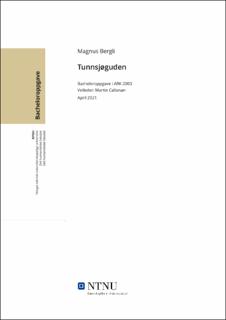| dc.contributor.advisor | Callanan, Martin | |
| dc.contributor.author | Bergli, Magnus | |
| dc.date.accessioned | 2021-09-13T16:07:04Z | |
| dc.date.available | 2021-09-13T16:07:04Z | |
| dc.date.issued | 2021 | |
| dc.identifier | no.ntnu:inspera:79993908:36748266 | |
| dc.identifier.uri | https://hdl.handle.net/11250/2775688 | |
| dc.description.abstract | Denne teksten handler hovedsakelig om hvordan man kan se etter samiske hellige områder ved hjelp av stedsnavn, arkeologi, skriftlige kilder og ikke minst de muntlige kildene som etter hvert har blitt skrevet ned etter de har blitt formidlet. Det hellige stedet denne teksten omhandler er Gudfjellhøye, nærmere bestemt Tunnsjøguden som skal være en stein på toppen av Gudfjellet der det skal ha blitt utført ofringer. På selve Gudfjellet er det ingen registrerte kulturminner, og det er heller ikke vert gjort noen arkeologiske undersøkelser på dette stedet. Dermed må man blant annet bruke flere andre kiler man har tilgjengelig, og det man har mest av er sagn og religiøse ofringer og andre aktiviteter på fjellet. I tillegg til de muntlige kildene kan man også se på stedsnavnet der det kan fortelle oss ganske mye om selve stedet. Når stedet i seg selv har navnet gud i seg, er det lett å forestille seg at det har vært et område av religiøse severdigheter. Den siste kilden er å se på aktiviteten på området i rundt Tunnsjøen for å finne ut hvor langt tilbake i tid dette stedet har blitt brukt av mennesker, i tillegg til hyppigheten av menneskelig bruk. Det blir dermed sett på alle disse kildene for å finne ut hva som er begrunner for fjellet er blitt kald «tunnsjøguden». | |
| dc.description.abstract | This text is mainly about how one can look after a holy Sami place with helps from sources lake the placename, with use of archaeology, written sources and maybe the most important one, The oral sources. The holy place this text will go about Is a place could “Gudfjelløya” or as translated to English “the God mountain island”, rather sad the place could “Tunnsjøguden” which is translated to the “Tunnsjø God”, which is a plateau or a stone on the top of the mountain where the scarification has taken place. The island itself does not have any registered archaeology finds, but the place around the lake Tunnsjøvatnet has quite a bit more finds. Even though there are not many finds on the island itself, the island has rather quote a bit more of oral sources and have quite a bit of written sources as well. The name of the place itself is quite a god source when it comes to place. Since the name itself has the world God in it, means that the place probably has had a lot to do with religion. To clarify of much activity the place has seen, is there a lot to look for when in comes to the big region of land around the lake. Which is where the source of archaeology is important. The text main purpose is to figure out how one can say that this place Is and has been a holy place. With that the course will also be looking inn to the Sami culture and howe it made to be such a prevalent place for the Sami people. | |
| dc.language | nob | |
| dc.publisher | NTNU | |
| dc.title | Tunnsjøguden | |
| dc.type | Bachelor thesis | |
